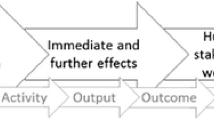Abstract
Goal, Scope and Background
To enhance the use of life cycle assessment (LCA) as a tool in business decision-making, a methodology for Social life cycle impact assessment (LCIA) is being developed. Social LCA aims at facilitating companies to conduct business in a socially responsible manner by providing information about the potential social impacts on people caused by the activities in the life cycle of their product. The development of the methodology has been guided by a business perspective accepting that companies, on the one hand, have responsibility for the people affected by their business activities, but, on the other hand, must also be able to compete and make profit in order to survive in the marketplace.
Methods
A combined, bottom-up and top-down approach has been taken in the development of the Social LCIA. Universal consensus documents regarding social issues as well as consideration for the specific business context of companies has guided the determination of damage categories, impact categories and category indicators.
Results
Discussion, and Conclusion. The main results are the following: (1) Impacts on people are naturally related to the conduct of the companies engaged in the life cycle rather than to the individual industrial processes, as is the case in Environmental LCA. Inventory analysis is therefore focused on the conduct of the companies engaged in the life cycle. A consequence of this view is that a key must be determined for relating the social profiles of the companies along the life cycle to the product. This need is not present in Environmental LCA, where we base the connection on the physical link which exists between process and product. (2) Boundaries of the product system are determined with respect to the influence that the product manufacturer exerts over the activities in the product chain. (3) A two-layer Social LCA method with an optional and an obligatory set of impact categories is suggested to ensure both societal and company relevance of the method. The obligatory set of impact categories encompasses the minimum expectations to a company conducting responsible business. (4) A new area of protection, Human dignity and Well-being, is defined and used to guide the modelling of impact chains. (5) The Universal Declaration of Human Rights serves as normative basis for Social LCA, together with local or country norms based on socio-economic development goals of individual countries. The International Labour Organisation's Conventions and Recommendations, and the Tripartite Declaration of Principles concerning Multinational Enterprises and Social Policy, support development of the impact pathway top-down, starting from the normative basis. (6) The obligatory part of Social LCA addresses the main stakeholder groups, employees, local community and society.
Recommendations and Outlook
Social LCA is still in its infancy and a number of further research tasks within this new area are identified.
Similar content being viewed by others
Author information
Authors and Affiliations
Corresponding authors
Rights and permissions
About this article
Cite this article
Dreyer, L., Hauschild, M. & Schierbeck, J. A Framework for Social Life Cycle Impact Assessment (10 pp). Int J Life Cycle Assessment 11, 88–97 (2006). https://doi.org/10.1065/lca2005.08.223
Received:
Accepted:
Published:
Issue Date:
DOI: https://doi.org/10.1065/lca2005.08.223




